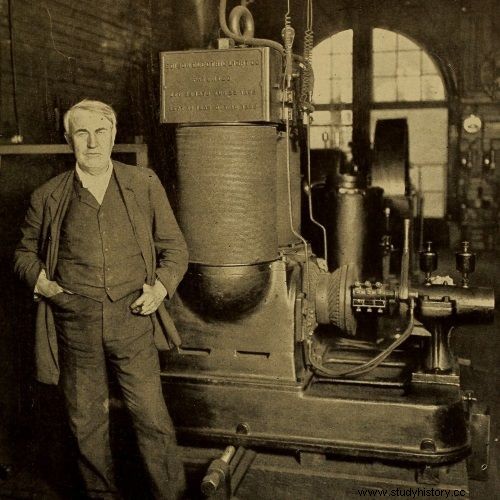He lied, stole, blackmailed and intimidated. He destroyed and spat upon the real explorers. And he himself became the idol of the press and an icon of an entire era. Do you also believe in the fairy tales told about him?
Thomas Alva Edison is mentioned in school textbooks as the one who lit up the darkness with the help of an electric bulb. Anyway, he adhered to this version himself during his lifetime and even had appropriate documents for it, issued by the state office.

Thomas Alva Edison in 1911. (photo:public domain)
Of the 400 filed jointly by him and his Menlo Park employees and the 1,000 owned by Edison himself, this patent was paramount. On January 27, 1880, the US government issued Document No. 223 898 for the construction of an "incandescent lamp". From then on, Edison kept everyone in check.
Dirty game
The man considered to be one of America's greatest inventors was definitely not an angel. Every now and then there was evidence that the game was dirty. For example, when, during his visit to the world exhibition in Paris in 1889, with the help of a telegraph he sent ideas for new inventions and patents to his laboratories ... observed at the competition's stands.
Besides, Edison was no stranger to industrial espionage and stealthy seizure of other people's inventions. This was the case with the movie projector. His invention was not entirely good, so he bought a better model from other inventors, renamed it, patented it and considered himself the only person entitled to earn money from "moving pictures". He also threatened to prosecute anyone who infringed his patent law.

An apparently nice old man, he was in fact a ruthless businessman. (photo:public domain)
It was one of his utterly side scams. Edison, who runs the Edison Electric Light Company, wanted a monopoly on supplying Americans with light, which would generate a fabulous income. To get rid of the competition, he bought out those he could, and decided to intimidate, destroy, smear the rest in the press or sue for infringement of a priceless bulb patent. The story of one of these inventors' wars was described by Oscar winner Graham Moore, in his novel The Last Days of Darkness. A dispute that electrified the world ” .
Great war for electricity
The storyline focuses on the fight between Edison Electric Light Company and Mount Morris Electric Light Company, which has gone down in history. The owner of the second company was George Westinghouse, who, competing with Edison, decided to use the idea of a Serbian immigrant - Nikola Tesla.
The alternating current he used allowed him to save expensive copper (required thinner cables) and to transmit electricity over long distances. Edison, unable to win in the technological field, decided to sue a competitor and destroy it because the bulbs sold by Westinghouse were similar to his patented ones. The most important question in the whole dispute, however, was whether it could have rights to the very concept of the bulb - and not just to one variant of it.
Thomas Edison was convinced of it. It should be remembered, however, that the first show of electric lamps was organized ... over 70 years before he patented his invention! In 1806, Sir Humphry Davy connected a battery to carbon rods, causing the current to form an arc between them. The arc emitted a bright flash of light. In turn, the Scottish inventor James Bowman Lindsay in 1835 presented a permanent electric light to the public and then abandoned the topic and started working on a wireless telegraph.
Marcellin Jobard, an inventor from Belgium, created a carbon-filament vacuum bulb in 1838. In 1874, Alexander Nikolaevich Lodygin, a Russian inventor, received the Petersburg Academy of Sciences Award for light bulbs. He built his light source in 1872. It was a primitive light bulb with a filament in the form of a carbon rod.

George Westinghouse. The man who stood up to Edison's mighty empire and… survived. (photo:public domain)
Heinrich Göbel claimed in 1893 that he had invented a carbon filament light bulb as early as 1854 , very similar to the one Edison patented. In 1874, Henry Woodward and Mathew Evans invented their own light bulb. However, they failed to make a fortune on the project and ... they sold their patent to Edison in 1879, just before he patented his own "invention".
Ultimately, Thomas Edison failed to finish George Westinghouse. Instead, he let the reins of his empire fall from his hands and withdrew. His successors removed the founder's name from the name of the company and resigned from fierce litigation with competitors, recognizing that it simply did not pay off. If something survives it's a myth. Because until today it is repeated in textbooks that Edison is responsible for the invention of the light bulb. Although a whole bunch of real explorers had already done it before ...
Bibliography:
- Adair G., Thomas Alva Edison:Inventing the Electric Age , New York 1996.
- Jonnes J., Empires of light , New York 2003.
- Sonneborn L., The Electric Light. Thomas Edison's Illuminating Invention , New York 2007.
- The Britannica Guide to Inventions that Changed the Modern World , eds. R. Curley, New York 2010.
